Ma Deuce
.jpg)

.gif)

3,000 RPM on a bicycle! In September 2013, Sebastiaan Bowier set the flat-surface bicycle speed record at 83.13 miles per hour. That’s some serious pedal pushing.
I’m not sure who mounted a Villar Perosa M1915 machine gun on a bicycle, or when, or even why they did it. What I am sure of is that it has to be the greatest amount of firepower ever mounted aboard a bike. Regardless of how fast the cyclist can pedal, the Villar Perosa spits out 9 mm Glisenti ammo at up to 1,500 rounds per minute. Even I can do the math, and with its twin barrels, the little Italian dynamo rattles out up to 3,000 rounds per minute. Mama Mia, that’s 50 rounds per second!
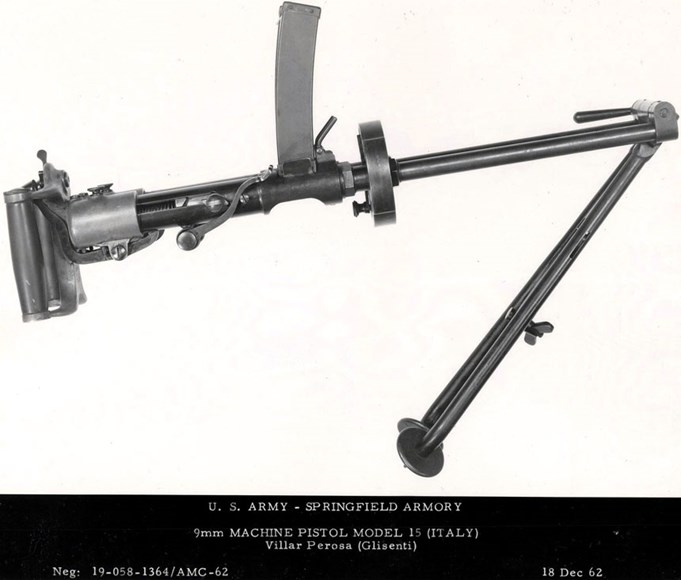
The most common configuration of the M1915 Villar Perosa, equipped with a lightweight, folding bipod.
With just 25 rounds in each top-mounted magazine, the firer will only get a one-second squeeze on each of the thumb-button triggers on the Villar Perosa’s spade-grips. I have no data on speed-reloading Villar Perosa magazines while in the act of pedaling, but you’d likely get quite a workout riding back and forth from the ammunition dealer.

M1915 Villar Perosa on its transit case. Note the rear sight, built into the spade grips.
A relative unknown: The strange little M1915 Villar Perosa was the first true submachine gun in action during World War I. No one seemed to consider it a “subgun” though, and to be fair, no one really knew the category even existed at that time. Featuring the side-by-side coupling of identical guns, the Villar Perosa was usually operated as the world’s lightest crew-served weapon. The twin-gun arrangement weighs just slightly more than 14 lbs., with the occasional addition of an armored shield weighing far more than the weapon itself.
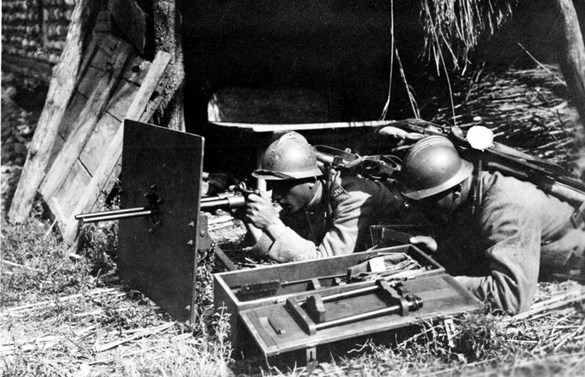
Troops firing the Villar Perosa though its weighty shield.
The “crew-served” description comes from the necessity to have several men focused on reloading the rapid-firing little weapon. I suspect that overheating would have been a significant problem during any extending firing. Various mounts were used, all seemingly more awkward than the next, this including an unconscionable shoulder-stock arrangement that kept the spade grips and the thumb-button triggers. Villar Perosa fires from an open bolt, on full-automatic only. Magazines are inserted from the top, and spent casings are ejected from the bottom. The sights are rudimentary: the rear sight is built into the spade grips, while the front sight is integrated into the front plate that joins the two barrels.
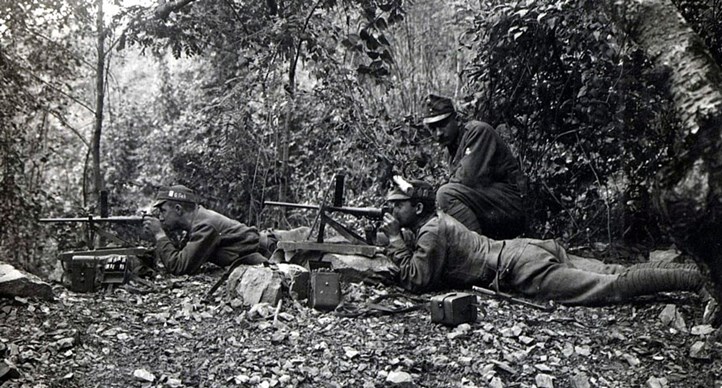
Austro-Hungarian troops with captured M1915 Villar Perosa SMGs. Note the lightweight tripod and metal baseplate.
Some attempts were made to mount the Villar Perosa on aircraft (as an observer’s weapon, and also placed on the upper wing for the pilot to use), but the 9 mm Glisenti rounds proved to be far too weak, lacking the range and penetrative power for air-to-air work. With all things considered, the bike mount makes as much sense as most wartime mountings for the M1915 Villar Perosa. Plus it is a helluva’ lot more manly than your average bicycle bell.
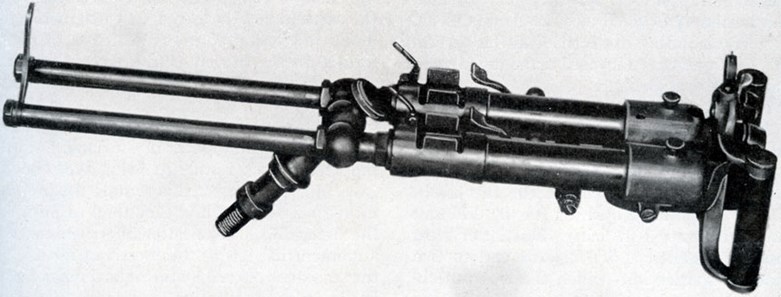
The M1915 Villar Perosa shown without the top-loading magazines. Note the centrally-mounted sights.
A design pointing to the future: Despite the Italians’ struggles to find a strong tactical application for their incredible little bullet-sprayer, the battlefield potential of the M1915 Villar Perosa was clear. The lightweight bipod and tripod mounts were most useful for the Alpini, Italy’s mountain troops that spent most of the Great War fighting the Austro-Hungarian forces in the Alps. The Villar Perosa’s suppressive fire capability was unmatched at that time. Sustained fire however, was a completely different story.
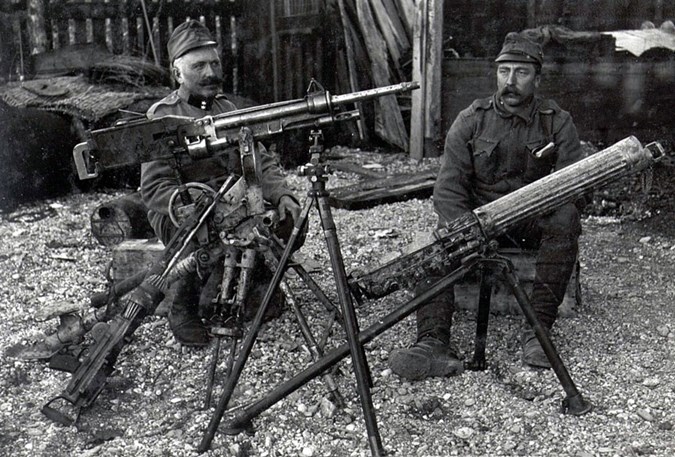
Austro-Hungarian troops with machine guns captured from the Italians: the French St Etienne Mle 1907 (left rear), the Vickers Mark I (right rear), the Lewis Mark II and the M1915 Villar Perosa.
During 1918, the twin barrels of the M1915 Villar Perosa were split up. The new OVP M1918 was redesigned as an automatic carbine, retaining the top-mounted magazine, and using new offset sights. Berretta also got involved, and adapted the Villar Perosa design to create its Model 1918 (the cyclic rate was brought down to a more manageable 900 rounds per minute). This was one of the world’s first conventional submachine guns. Of course, Berretta would go on to design many more SMGs, creating some of the best submachine guns of all time. Against this backdrop, the Villar Perosa would quietly fade into full-auto obscurity.
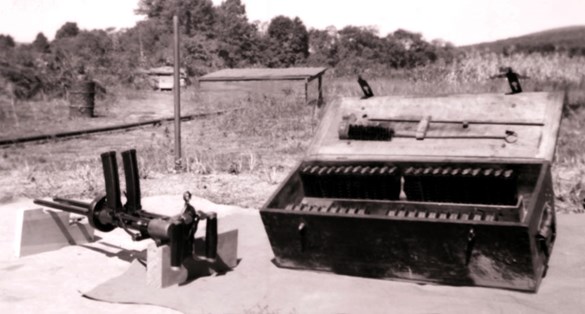
M1915 Villar Perosa showing details of its transit case: multiple 25-round magazines, and cleaning kit.
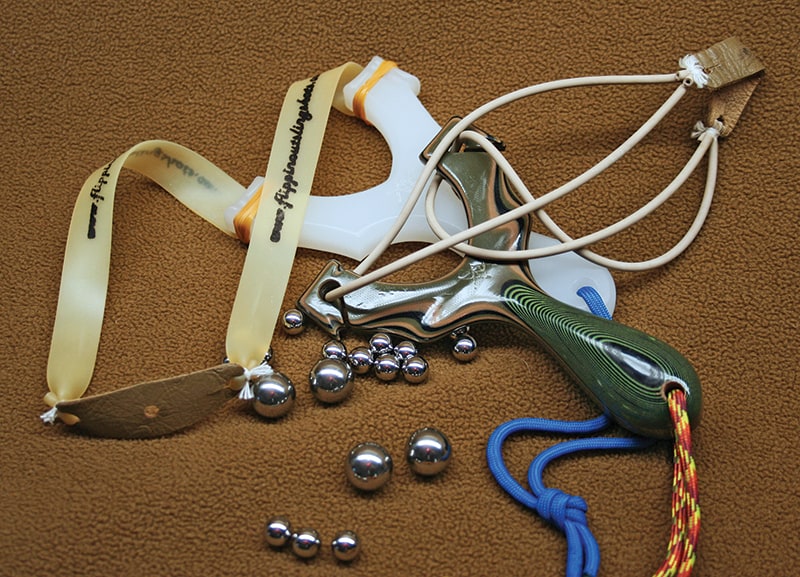
Long, long ago, in a galaxy far away… (Seems like that, anyway.)
I was training a bunch of high-speed, low-drag operators of the Grand Exalted Ninja variety, and wow, were they impressive! Agile as combat monkeys, faster than tactical cheetahs, they poured out full-auto firepower like the USS Iowa. But there were a few piddly little problems.
First, given their gargantuan consumption of munitions, each trigger-puller would require the services of two pack mules to haul their ammo. Second, if they had to make controlled shots, they couldn’t shoot Minute-Of-Manhole-Cover (MOMC). Command staff noticed this aberration amongst their anointed, and lacking any intelligent ideas, they called me.
Fit, But…
These troops were physical prodigies and highly intelligent. Their equipment was first-rate, and their initial training excellent. But once they had reached operational level, they were essentially cut loose and set adrift. “Hollywood Effect” kicked in. They shot more and faster in increasingly sophisticated training environments, but they were on their own, with no eyeballs-on critical oversight coaching. Any top shooter can tell you that today’s un-critiqued champion is tomorrow’s last-place loser.
Over time, the result was predictable: Unconsciously developed bad habits became pronounced and then ingrained. As their accurate hit ratio fell, they increased the speed and volume of fire. While other tactical techniques sharpened, their fundamentals foundered. I tried a technique discovered by some smart Brits.
Their regiment included a ceremonial unit of archers to uphold tradition and entertain civilians at public events. When several vacancies went unfilled by volunteers, a bunch of notably poor shooters were assigned. The archery coaches were perfectionists and ferocious disciplinarians. Qualifying with firearms was one thing, but the publicly-witnessed performance of their archers was, as they would say, bristling, with clenched teeth, “Quite another matter entirely, old man! The regiment’s honour, you know.” When those involuntary archers picked up their rifles again, they amazed their NCOs — and themselves.
It worked for them, for me, and it can work for you. Three Keys: Fundamentals, Fundamentals, and FUNDAMENTALS!
Just as it is with long guns and handguns, archery demands hand-eye-head coordination, creating a stable platform even under difficult and fluid conditions, consistently repeated positions and points of contact, breathing control, a crisp, clean release, and understanding that “follow-through” is a moment, not a movement. In practice and for correcting lapses in performance, the advantage archery holds over live firearms training is the lack of distraction by noise, muzzle blast, recoil and mechanical action movement, which can both induce and conceal faulty technique. Archery is unforgiving, and errors are magnified and clearly apparent.
Shortly after that experience, I ran into a guy who was doing the same kind of thing in West Africa using blowguns, another discipline demanding many of the same honed skills. “And,” he added, “In poor weather, it can be practiced inside a big mud-wattle hut or under a tin railway-stop roof. And, the local rat population — filthy beasts — was decimated.” Shooting skills skyrocketed.
I learned some good stuff. Then, of course, I forgot it — almost. I was talking with Simon Lee, a honcho with Mad Bull AirSoft, makers of premium airsoft handguns and rifles. Due to legal restrictions on and extreme costs of firearms, airsoft is huge in Japan, where many top IPSC competitors train with airsoft, then kick competitive butt with firearms. And lots of Japanese shooters are also avid archers. Hmm …
A few days later, I met Nathan Masters, a dedicated shooter, owner and chief designer of FlippinOut Slingshots. I quickly learned how he polished his essential pistol skills — hand-eye-head coordination, breathing and release — with slingshots and more: He had not only independently discovered the firearms-training benefits of archery and blowguns but was about to launch a new enterprise and website covering all three disciplines at simple-shot.com. Yeah, I’m getting back into them now — and maybe you should consider them too.
Practical, Fun Alternatives
For many good reasons, airsoft is a low-cost, highly effective alternative shooting sport, and all manner of guns are available. Even very high-end models, licensed by major makers like Daniel Defense, Barrett and Noveske are surprisingly affordable. To minimize ongoing expense, I recommend spring-air powered and rechargeable-battery powered AEG (Automatic Electric Gun) models rather than CO2 types.
If you’re considering archery, I recommend you find an archery center with an indoor range, rental gear, and low-cost basic instruction. Tell them you want to try both conventional bows and compound bows. There are lots of good books and videos available on the subject, but nothing beats live instruction and coaching. Typically, archers delight in introducing people to their sport, and those in the business tend to be very patient and supportive.
When my son and I took up archery, after familiarization with recurve bows, we bought low-end Browning compound bows from Gander Mountain. After putting in lots of time and practice, we considered more sophisticated and far more expensive bows, but in the end, realizing our “cheap-os”—not cheap, but inexpensive—gave us all the capability we needed for both recreational shooting and hunting, we decided to put our money into more and better arrows. You don’t have to go overboard to be a well-equipped archer. Browning doesn’t offer bows anymore, but PSE Archery has made Browning’s bows for years, and they’re excellent.
You don’t need Herculean lungs or wads of money to take up blowguns. The variety of blowguns and darts available is astounding, and you can practice indoors or out. Much of blowgunning is intuitive, but the hand-eye-head coordination and breath control involved is terrific training, and as with archery, improvement is rapid and obvious. Generally, I recommend you start with an inexpensive 36″ or 48″ .40-caliber blowgun, and if that whets your interest, upgrade from there. Their range and power might amaze you.
If you haven’t flipped a slingshot since BFH — Before Facial Hair — you’ll be blown away by today’s slingshot smorgasbord. Having looked around, I don’t think anybody offers better slingshots than Nathan Masters at simple-shot.com. His models range from $20 to $175, yet all of them pack great accuracy and small-game hunting capability. The biggest modern advances in slingshots are in the bands and the structural quality and consistency of the frames, making a huge difference. These ain’t your granddaddy’s flippers — and they can definitely make you a better firearm shooter!
So give it a shot: sharpen your skills — and have fun!
Connor OUT
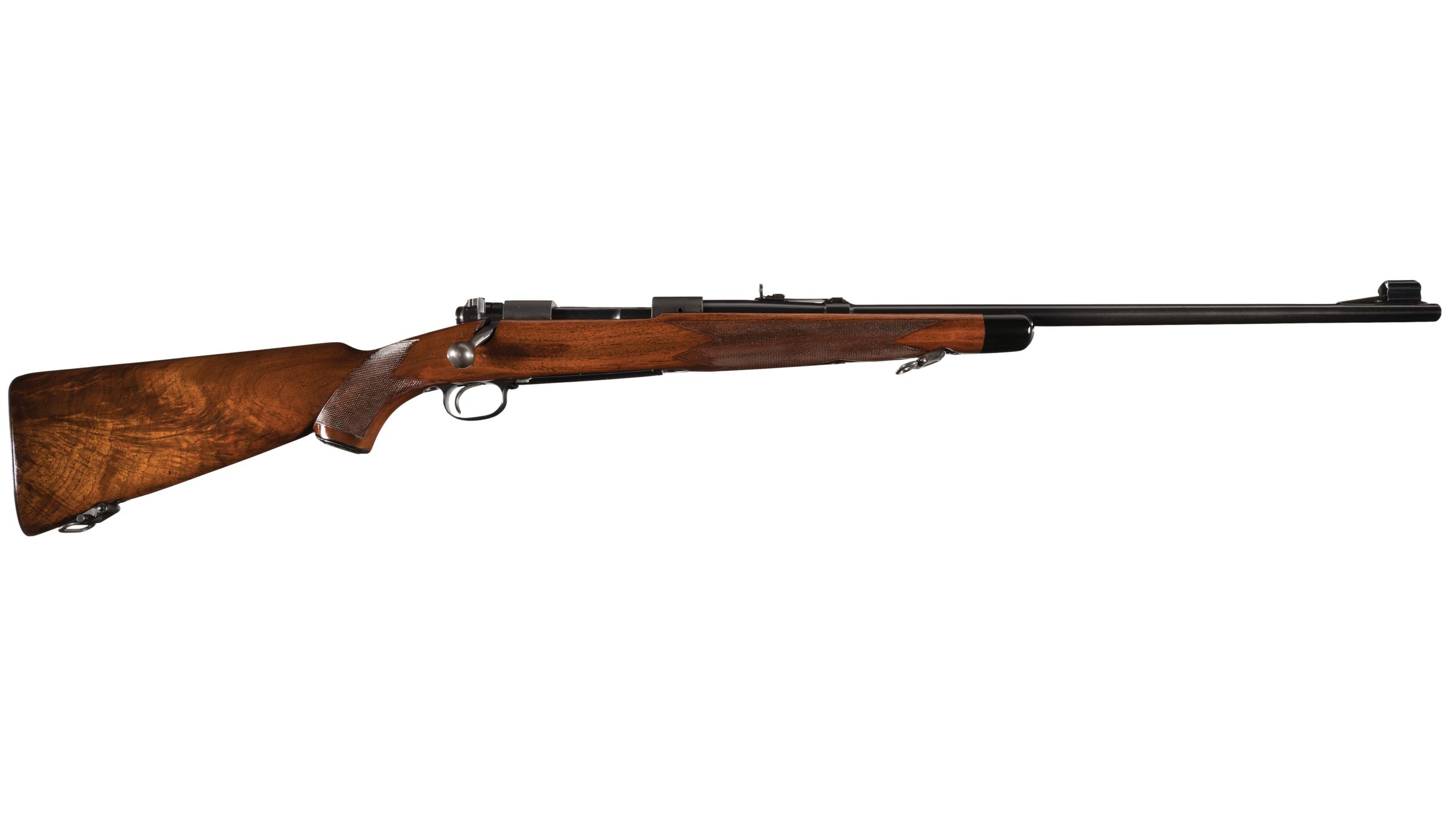
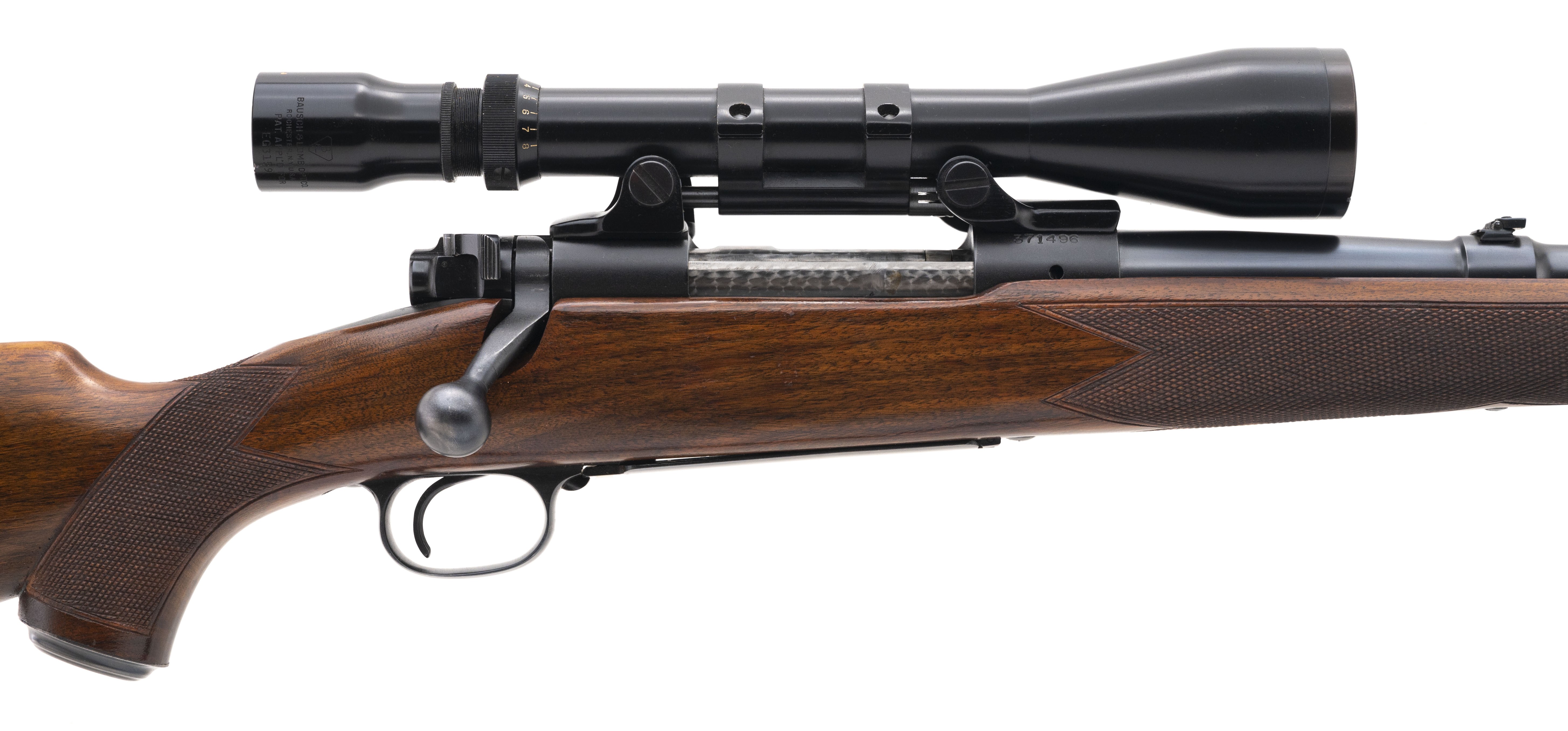

One of the most long-lived firearms in the U.S. military arsenal is the M2 .50-cal. Browning Machine Gun, which has been in service for nearly 100 years. It’s one of the most recognizable military firearms on Earth, but while the M2 Browning continues to operate, it couldn’t have existed without extensive trials and development.
Along that development path, Colt stepped out with its commercial Model 1924 Automatic Machine Gun, which was sold to nations throughout the ’20s, ’30s and into the early years of World War II. In the American Rifleman Tech Files, past editors have preserved an original handbook detailing the components and operation of the Colt Model 1924.
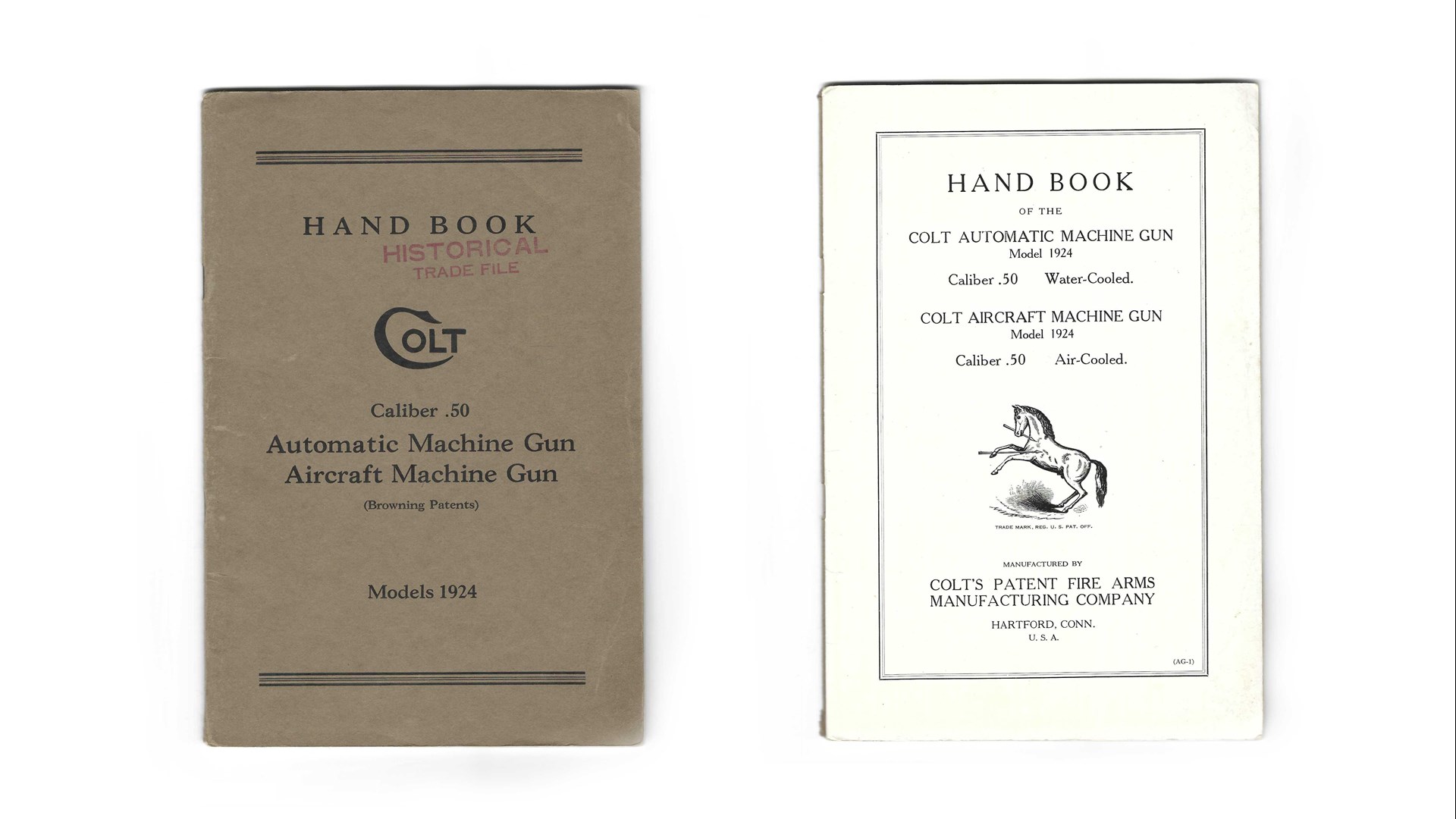 The manual details the gun’s capability and necessary maintenance procedures to newly minted owners flipping open the booklet for the first time. “The Colt Automatic Machine Gun, Model 1924, cal. 50, is a water jacketed, recoil operated machine gun of the heavy class type, fed from a belt holding 100 rounds of ammunition arranged in horizontal layers in a feed box attached to the tripod.
The manual details the gun’s capability and necessary maintenance procedures to newly minted owners flipping open the booklet for the first time. “The Colt Automatic Machine Gun, Model 1924, cal. 50, is a water jacketed, recoil operated machine gun of the heavy class type, fed from a belt holding 100 rounds of ammunition arranged in horizontal layers in a feed box attached to the tripod.
It is capable of sustained fire, and is particularly suited for direct, indirect, overhead, and barrage fire for anti-aircraft and tank service, being of larger caliber than the Caliber .30, with consequent increased charge and projectile, a feature accomplished without a proportionate increase in the weight of the gun.”
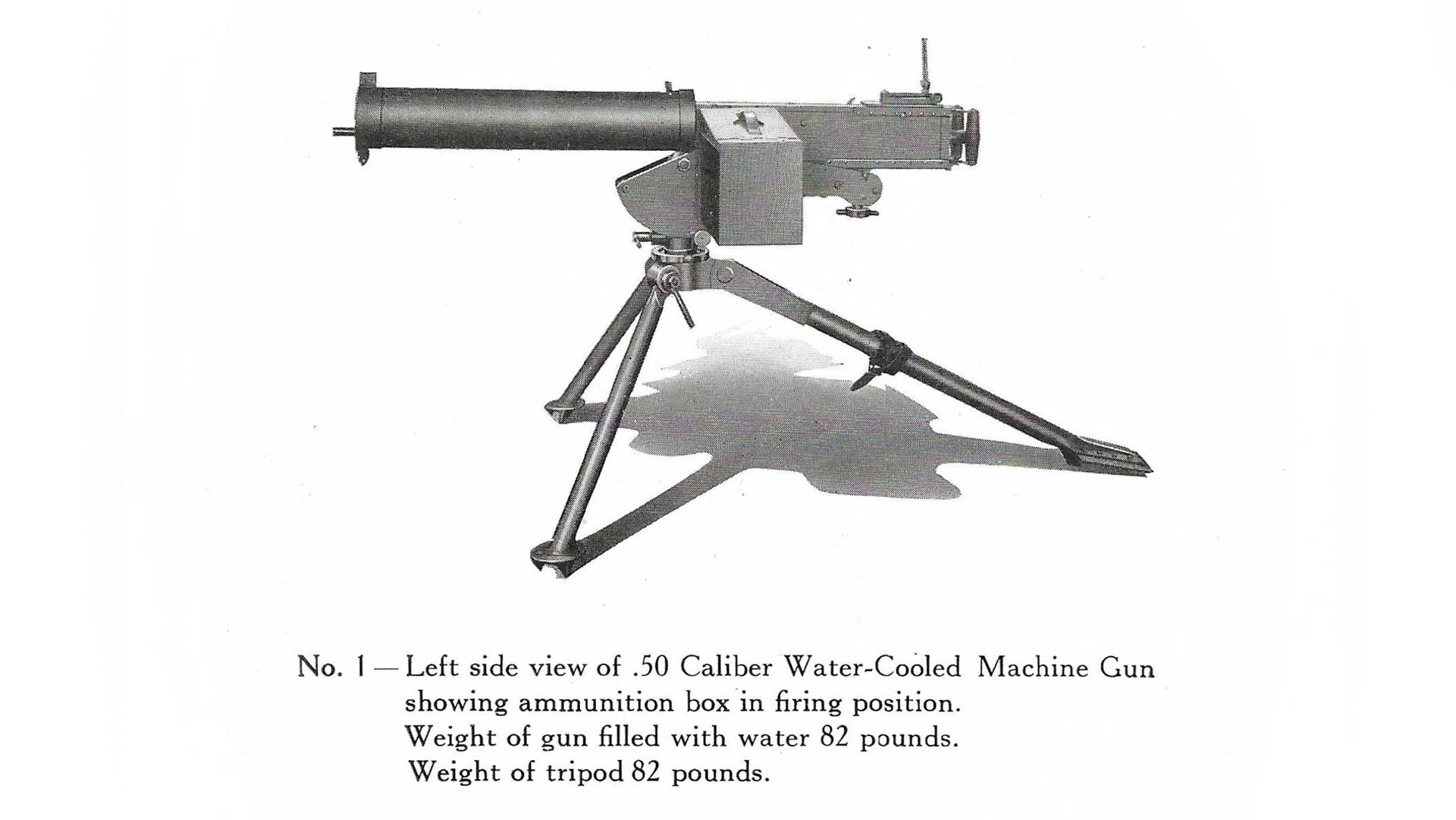 While the increase may have not been proportionate, as the M1917 Browning of the World War I era weighed just over 100 lbs. loaded with water and ammunition, there’s no question that it still wasn’t substantial. Together with the tripod and a full jacket containing two gallons of water, the gun weighed more than 180 lbs. Colt also extolled the virtues of this commercial design to other prospective buyers in its handbook.
While the increase may have not been proportionate, as the M1917 Browning of the World War I era weighed just over 100 lbs. loaded with water and ammunition, there’s no question that it still wasn’t substantial. Together with the tripod and a full jacket containing two gallons of water, the gun weighed more than 180 lbs. Colt also extolled the virtues of this commercial design to other prospective buyers in its handbook.
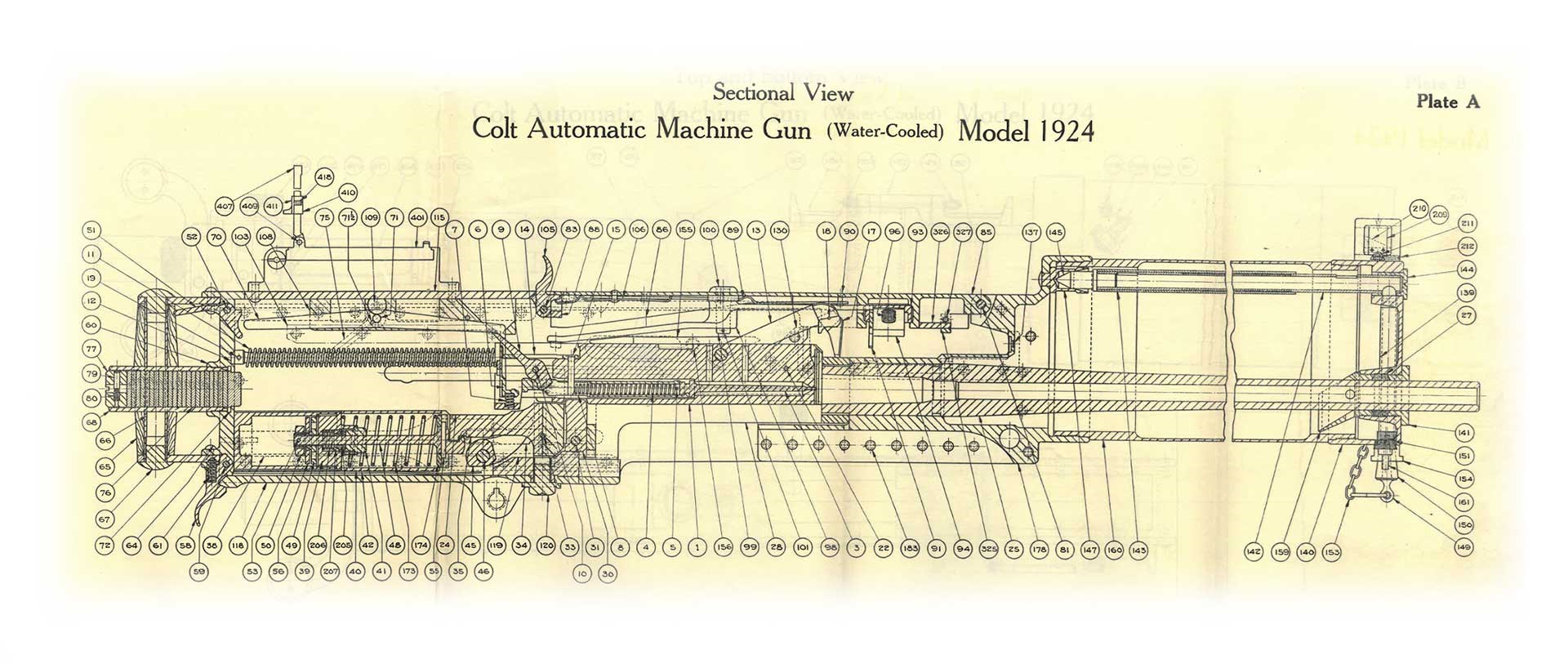 “The gun is composed of only about forty main parts which can be disassembled and assembled in the field with great ease and rapidity. It is superior to all other machine guns of its type in that it is composed of fewer and more durable parts; has less vibration by reason of its reciprocating action and combines light weight with greater durability.
“The gun is composed of only about forty main parts which can be disassembled and assembled in the field with great ease and rapidity. It is superior to all other machine guns of its type in that it is composed of fewer and more durable parts; has less vibration by reason of its reciprocating action and combines light weight with greater durability.
On its mount it possesses a wide angle of depression and elevation; swings in a complete arc and can be shot from the prone position. Can be fired up to 500 shots without replenishing water in water jacket, and the operator is not hampered with the necessity of gas or spring adjustments. This gun was adopted by the U.S. Government as the result of a long series of tests during 1921-1922.”
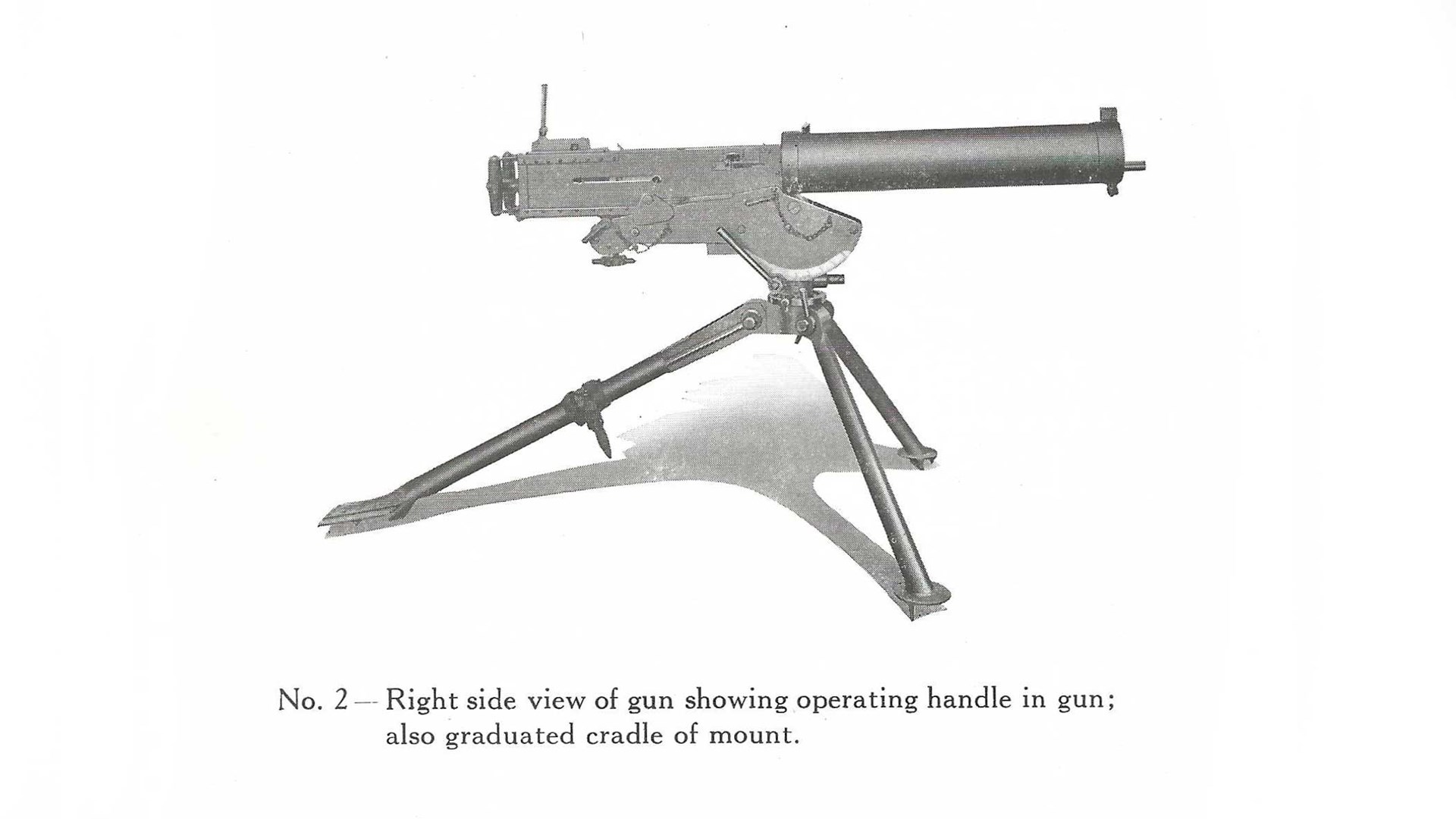 Again, as with so many marketing statements of the time period, there may have been kernels of truth, but it wasn’t wholly accurate. While the U.S. military had requested the earliest versions of what later became the M1921 Browning and was sold as the Colt Model 1924, in the early 1920s, things were still very much in the experimental stage. It wouldn’t be until the mid-1930s that the military officially began using what had been officially adopted as the M2 Browning.
Again, as with so many marketing statements of the time period, there may have been kernels of truth, but it wasn’t wholly accurate. While the U.S. military had requested the earliest versions of what later became the M1921 Browning and was sold as the Colt Model 1924, in the early 1920s, things were still very much in the experimental stage. It wouldn’t be until the mid-1930s that the military officially began using what had been officially adopted as the M2 Browning.
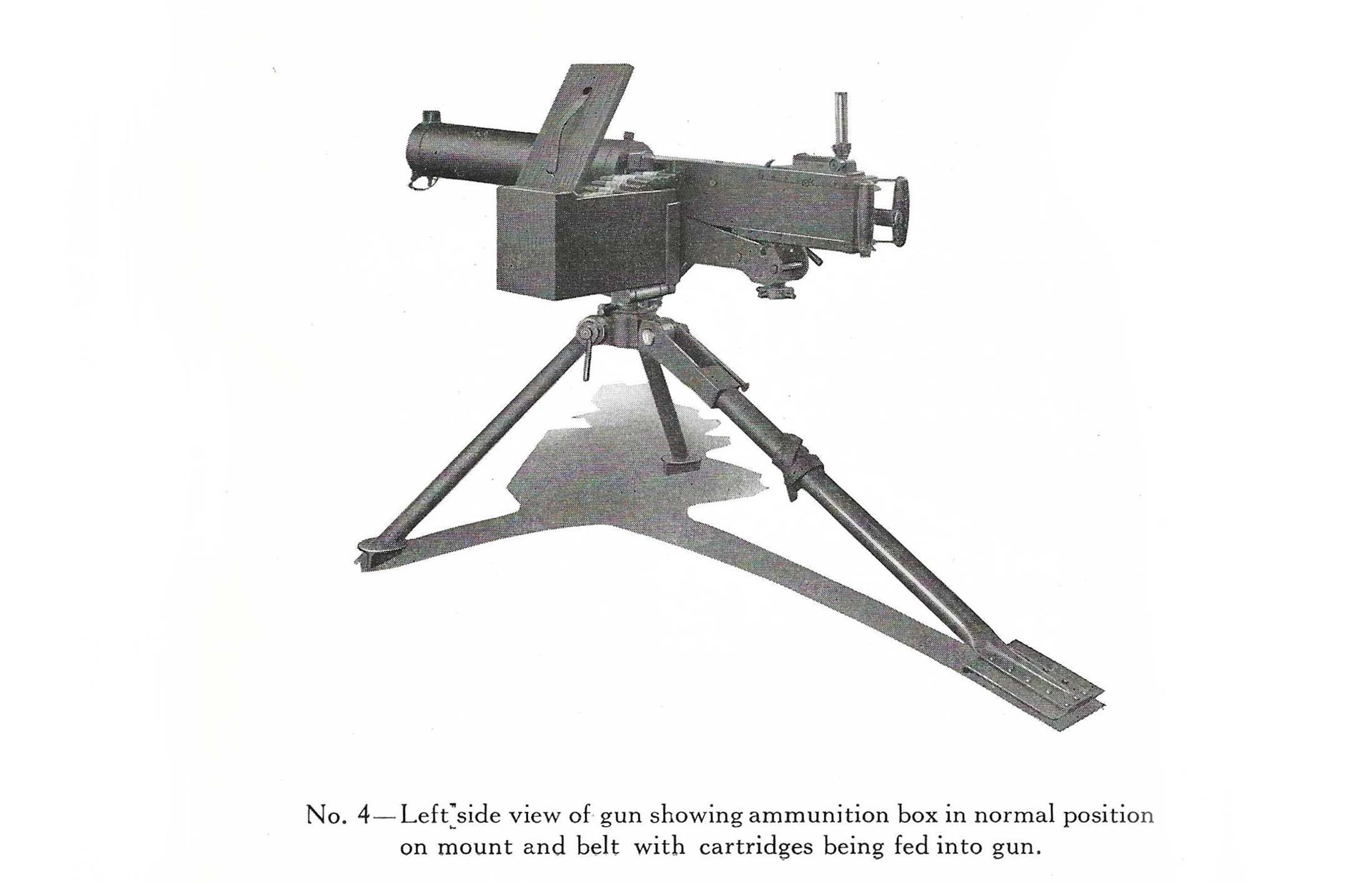 Additionally, headspace did require adjustment, but according to the manual, that could be performed easily without tools. One especially alarming note in the manual will strike modern-day readers, as Colt instructs users to “pack the barrel” in order to prevent water from escaping at the front and rear of the jacket, where the barrel entered and exited. The material of choice for packing? Asbestos.
Additionally, headspace did require adjustment, but according to the manual, that could be performed easily without tools. One especially alarming note in the manual will strike modern-day readers, as Colt instructs users to “pack the barrel” in order to prevent water from escaping at the front and rear of the jacket, where the barrel entered and exited. The material of choice for packing? Asbestos.
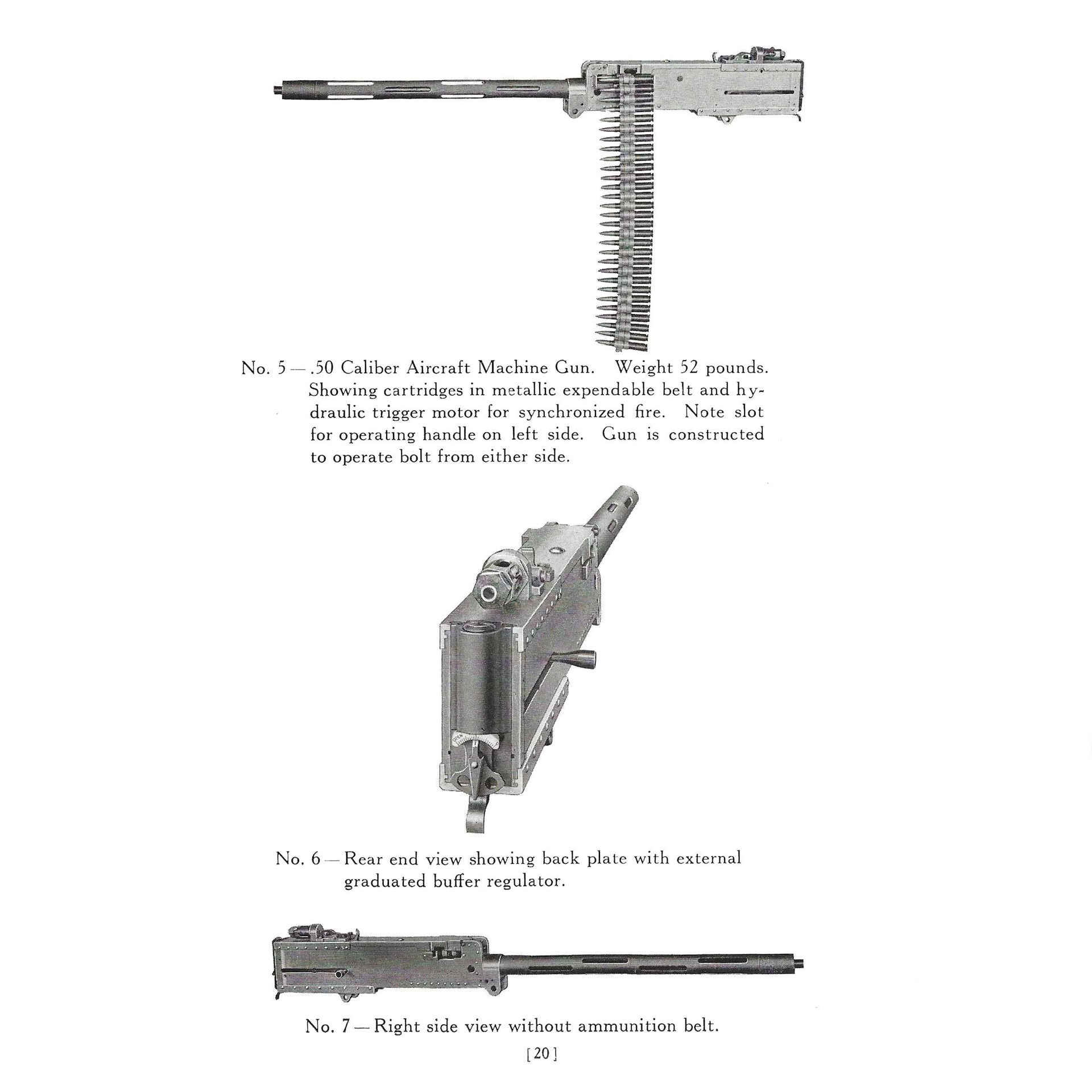 In addition to the water-cooled model, Colt also sold an air-cooled version of its Model 1924 as an “Aircraft Machine Gun.” Instead of a heavy, water-filled jacket, the aircraft model’s barrel was surrounded by a perforated tube that allowed air to circulate, thereby cooling the barrel.
In addition to the water-cooled model, Colt also sold an air-cooled version of its Model 1924 as an “Aircraft Machine Gun.” Instead of a heavy, water-filled jacket, the aircraft model’s barrel was surrounded by a perforated tube that allowed air to circulate, thereby cooling the barrel.
In the 1930s, Colt would change the name of these guns, calling the water-cooled model the MG52 and the air-cooled model the MG53, but the design remained the same. At the outset of World War II, Colt would dedicate all of its production capability to U.S. military needs, and that was the end of the line for the Model 1924.
